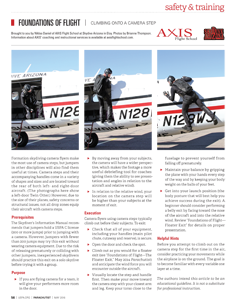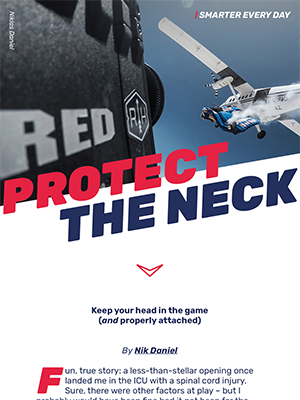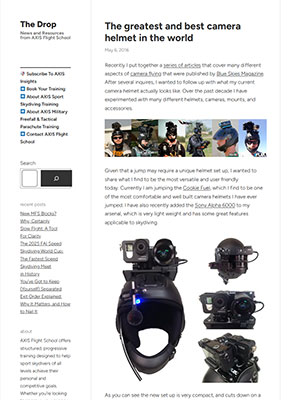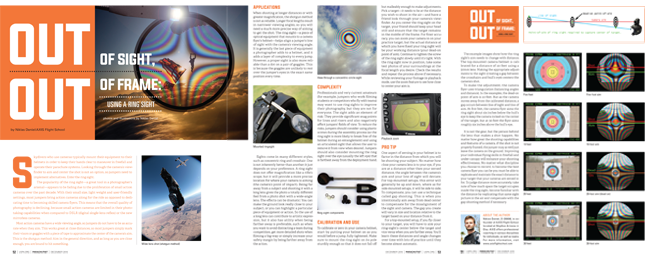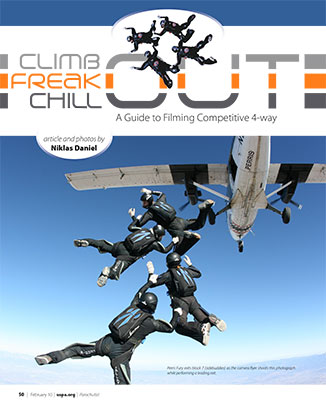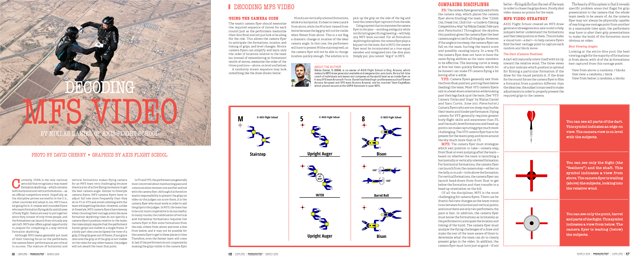Table of Contents
Jump to a chapter/section by clicking on it
or scroll through the complete topic.
Chapter 1: Solo Skills
Chapter 2: Equipment
Chapter 3: Competition
Section 1: FS
Section 2: MFS
Section 3: VFS
Chapter 1: Solo Skills

Climbing to a Camera Step
Article by Niklas Daniel. Visuals by by Brianne Thompson.
Formation skydiving camera flyers make the most use of camera steps, but jumpers in other disciplines will also find them useful at times. Camera steps and their accompanying handles come in a variety of shapes and sizes. However, due to the plane size, safety concerns or structural issues, they cannot be found at all drop zones.
[ Full Article ]

Protect the Neck — Keep Your Head in the Game (and Properly Attached)
Article by Niklas Daniel. Visuals by Niklas Daniek, hkgoldsteinO, Rockhouse Motion.
Fun, true story: a less-than-stellar opening once landed me in the ICU with a spinal cord injury. Sure, there were other factors at play – but I probably would have been fine had it not been for the amount of weight that was on my head that day.
[ Full Article ]
Chapter 2: Equipment

The Greatest and Best Camera Helmet in the World
Article by Niklas Daniel.
This is a follow up to a series of articles that cover many different aspects of camera flying. It shows what Nik's current camera helmet actually looks like. Over the past decade he has experimented with many different helmets, cameras, mounts, and accessories.
[ Full Article ]

Out of Sight, Out of Frame — Using a Ring Sight
Article by Niklas Daniel. Visuals by and illustrations by Niklas Daniel.
Skydivers who use cameras typically mount their equipment to their helmets in order to keep their hands clear to maneuver in freefall and operate their parachute systems. Looking through the camera's viewfinder to aim and center the shot is not an option. Enter the ring sight.
[ Full Article ]
Chapter 3: Competition
Competition > FS

A Guide to Filming FS 4-Way — Climb Out, Freak Out, Chill Out
Article by Niklas Daniel. Visuals by by Niklas Daniel.
This article is for jumpers who already have some experience flying camera and are trying to expand their knowledge of how to film formation teams in a competition setting. I will focus mainly on 4-way, because I believe it to be the most difficult formation skydiving discipline to film (aside from vertical formation skydiving), due to the many different exits and faster key speeds. However, once you have a firm grasp of shooting 4-way, the same principles can be applied to 8-way and larger formations.
[ Full Article ]
Competition > MFS

Decoding MFS Video
Article by Niklas Daniel. Visuals by by David Cherry and illustrations by Niklas Daniel.
Although MFS teams generally put most of their training focus on the performers, the camera flyers' performances are critical to success. The mixture of horizontal and vertical formations makes flying camera for an MFS team very challenging because there is a lot of active flying necessary to get the best camera angle.
[ Full Article ]
Competition > VFS

VFS Camera — Tricks and Traps
Article by Niklas Daniel and Sara Curtis; . Visuals by by Niklas Daniel.
Vertical Formation Skydiving (VFS) is a new and strongly emerging discipline, which combines the body-flight skills of freeflying and the mental skills of formation skydiving. In the past, very few skydivers have had the ability to take part in this discipline because it takes a certain level of proficiency of flight, and a complex understanding of formations. Today wind tunnels are springing up all over the globe, assisting skydivers in their quest for awesomeness. (…) In this article we are going to take a closer look at the camera flyer. Even though there may be some similarities in the responsibilities between camera flyers on the horizontal and vertical axis, with the addition of a greater fall rate speed and added dimensions of the formations, filming VFS is probably one of the most difficult disciplines to shoot. Here we check out some tricks and traps of this fun and challenging position.
[ Full Article ]

